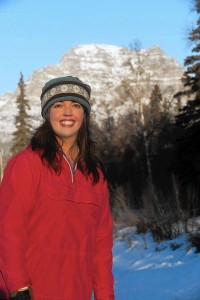 How to Be Brave isn’t just a book you read, it’s a story that you feel like you are living while reading, right down to sharing the symptoms and emotions of some of its characters. I didn’t just read this book, I experienced it, developed symptoms and was grateful for medicine and the time to rest and recuperate from it. But fear not, it’s totally worth the ride.
How to Be Brave isn’t just a book you read, it’s a story that you feel like you are living while reading, right down to sharing the symptoms and emotions of some of its characters. I didn’t just read this book, I experienced it, developed symptoms and was grateful for medicine and the time to rest and recuperate from it. But fear not, it’s totally worth the ride.
Natalie is the mother of 9-year-old Rose, whose father Jake is on a tour of duty in Afghanistan when Rose has a crisis which we learn is caused by a diagnosis of Type 1 diabetes. While they are in hospital both mother and daughter are visited and spoken to by a man who reassures them and whose voice leads them soon after to the discovery of dusty diary in a long abandoned box belonging to Natalie’s grandfather Colin.
As the two struggle to adapt to their new life routines that diabetes has forced upon them, they begin to share the story they have uncovered, of the destruction of the ship Colin had been working on and his long survival at sea before rescue.
The narrative of mother-daughter daily life and the passing of days at sea by Colin are interwoven so closely that we live the two simultaneously, there is a strong connectivity between what passes through the mind of young Rose and that of her great-grandfather.
They develop a routine that each time they must do the finger prick test and the insulin injection, they will narrate a portion of Rose’s great grandfather’s story; they don’t read from the diary however, rather, they take what they know and imagine the days, entering the minds and bodies of the men who shared the enormous challenge of trying to survive in a lifeboat floating with the currents at sea, and keeping their spirits up.
We meet Ken and Fowler and Scown and others and Scarface, the menacing shark that never gives up its pursuit, whose instinct is sharp and head-butting intentions lethal.
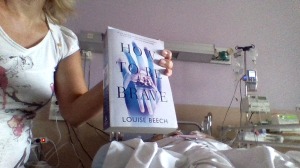 Louise Beech has created a page-turning, moving story that on Day 2 of reading, which was also Day 2 post-op for my daughter who also has Type 1 diabetes (diagnosed at 9 year-old), but who is recovering currently from spinal surgery to correct a scoliosis related curvature, I began to develop symptoms of headache, dehydration and my body ached all over. I wasn’t sure if it was sympathetic pain for my daughter or for Colin, I couldn’t read, just as Colin and the men couldn’t always find the energy to keep a lookout and gave into sleep, and so did I, after a quick trip to the pharmacy for medicine and water, so dehydrated! Miraculously, the next day I was completely fine.
Louise Beech has created a page-turning, moving story that on Day 2 of reading, which was also Day 2 post-op for my daughter who also has Type 1 diabetes (diagnosed at 9 year-old), but who is recovering currently from spinal surgery to correct a scoliosis related curvature, I began to develop symptoms of headache, dehydration and my body ached all over. I wasn’t sure if it was sympathetic pain for my daughter or for Colin, I couldn’t read, just as Colin and the men couldn’t always find the energy to keep a lookout and gave into sleep, and so did I, after a quick trip to the pharmacy for medicine and water, so dehydrated! Miraculously, the next day I was completely fine.
In between the created narrative which mother and daughter eventually share, coinciding with Rose taking more responsibility for doing her tests, preparing her insulin and even doing her own injections, they also open the diary randomly, using it as a kind of oracle and as one would expect, discovering just the reflection they needed to hear at that moment, as they travel their own journey.
Just as I do now with this book, while I live one day at a time with my daughter’s pain, and today as the morphine is removed and she has taken the paracetamol and all the medicine she is allowed, and the pain is still there and there is nothing more to give but a mother’s love, yes, I too open the book for reassurance and get this:
No one spoke. Even the sea seemed to listen, calm for a moment, its many colours merging into sparkling gold. Colin cut off thoughts beyond two days ahead. He was unable to imagine his hunger on so small an amount of food and so little water. Looking around at the craggy faces of his mates, he could see in their eyes the same fear. But it had to be. Much as the craving was there,they couldn’t eat more heartily for fear of how long rescue might be in coming.
Louise’s book has been my little escape these past four days, and these notes more like a journal than a review. I had intended to take a literary ocean escape with me during this time and meant to begin with Sheila Hurst’s Ocean Echoes which I will begin today, as she shares a similar love of the sea and ocean to me and likes the same kind of nature writing, however Louise’s book reached out to me and I decided to begin there, not realising how much of it takes place at sea. I couldn’t help noticing the synchronicity of this giant picture of a roiling sea, tossing a ship in its swell, right opposite us, the first thing I see every time I leave the room:
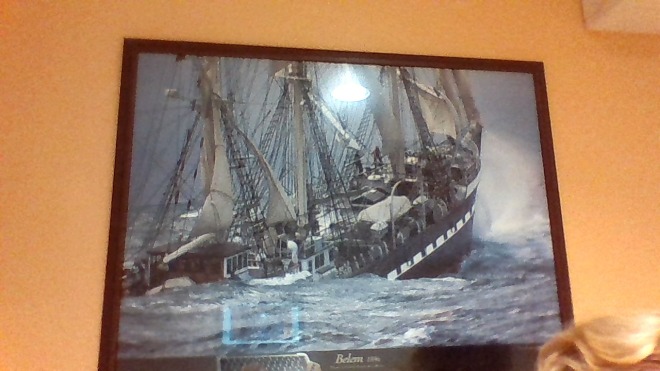
When Rose suggests she is ready to take more responsibility for her diabetes preparation and injections, her mother is initially reluctant, seeing her still as small child, wanting to avoid her immersion into the serious world of managing the medical challenge. In the same way she resists Rose’s desire to take up some of the storytelling, until Rose shares the words she’d whispered into Colin’s ear, during her night-time dream:
Rose patted my head, gentler now.
‘I said, If you don’t live, I’ll disappear Grandad. Can I call you Grandad? You’re really my Great Grandad, but I like Grandad better. If you don’t live Grandad, I won’t be able to come back and stroke your hair. I’ll just dissolve like a salty ghost. So then I got a bit of the canvas logbook and drew us all in there; you and me and Dad. I wrote above it that I was learning how to be brave, and he was making it a lot easier.
I loved everything about this book, brilliantly conceived and written, I would almost say channelled, as we are totally cast into Colin’s experience and made to feel it, and that doesn’t come from mere words scratched on a page. And I loved how mother and daughter become twin storytellers of the story, using their imagination, feeding into and drawing from their night dreams and day dreams and the bittersweet ending. Oh the magic of fiction and of life.
Highly Recommended.
Click Here To Buy A Copy of How To Be Brave
More Louise Beech I’ve Reviewed:








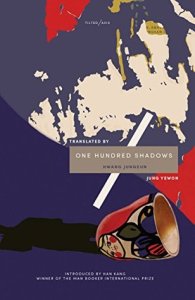 Ethereal, dream-like, accepting of their fate. South Korean working class literature.
Ethereal, dream-like, accepting of their fate. South Korean working class literature. Hwang Jungeun’s debut novel, translated by Jung Yewon was a critical and commercial success in South Korea with its mix of oblique fantasy, hard-edge social critique, and offbeat romance.
Hwang Jungeun’s debut novel, translated by Jung Yewon was a critical and commercial success in South Korea with its mix of oblique fantasy, hard-edge social critique, and offbeat romance. If you have read or were considering reading Marlon James Booker winning
If you have read or were considering reading Marlon James Booker winning  Unable to protect her daughter, who was raped by her schoolteacher, her focus moves to Janie, whom the daughter leaves her with. As soon as adolescence beckons she arranges for her to marry an older farmer with land. Janie dreams of love and fulfilment and when mentions not finding it in this marriage is reprimanded by her grandmother for her romantic notions.
Unable to protect her daughter, who was raped by her schoolteacher, her focus moves to Janie, whom the daughter leaves her with. As soon as adolescence beckons she arranges for her to marry an older farmer with land. Janie dreams of love and fulfilment and when mentions not finding it in this marriage is reprimanded by her grandmother for her romantic notions.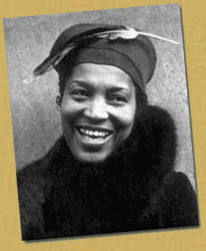
 The Humans sounded like a heart warming, entertaining read and something a little different to what I normally read. I chose it because it appeared to have something heart warming and yet humorous about humanity. It did, the perfect light read for those periods when you can’t handle anything too demanding.
The Humans sounded like a heart warming, entertaining read and something a little different to what I normally read. I chose it because it appeared to have something heart warming and yet humorous about humanity. It did, the perfect light read for those periods when you can’t handle anything too demanding. Eliminating those in the know proves an easier task than winning over the wife and son, however he perseveres and begins to understand and even value what it means to be human, developing an attraction to its quirks and foibles, despite the many bizarre acts they indulge.
Eliminating those in the know proves an easier task than winning over the wife and son, however he perseveres and begins to understand and even value what it means to be human, developing an attraction to its quirks and foibles, despite the many bizarre acts they indulge.
 The Ballroom is Anna Hope’s second novel and one inspired in part by a family connection. I review it in full at
The Ballroom is Anna Hope’s second novel and one inspired in part by a family connection. I review it in full at 


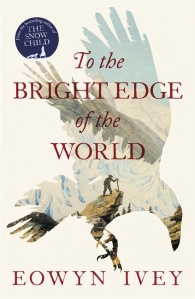 Eowyn Ivey was the author of my favourite book of 2012 and one of my all time favourite reads, her debut novel
Eowyn Ivey was the author of my favourite book of 2012 and one of my all time favourite reads, her debut novel 

 And in a style true to Eowyn Ivey and familiar from her novel
And in a style true to Eowyn Ivey and familiar from her novel 